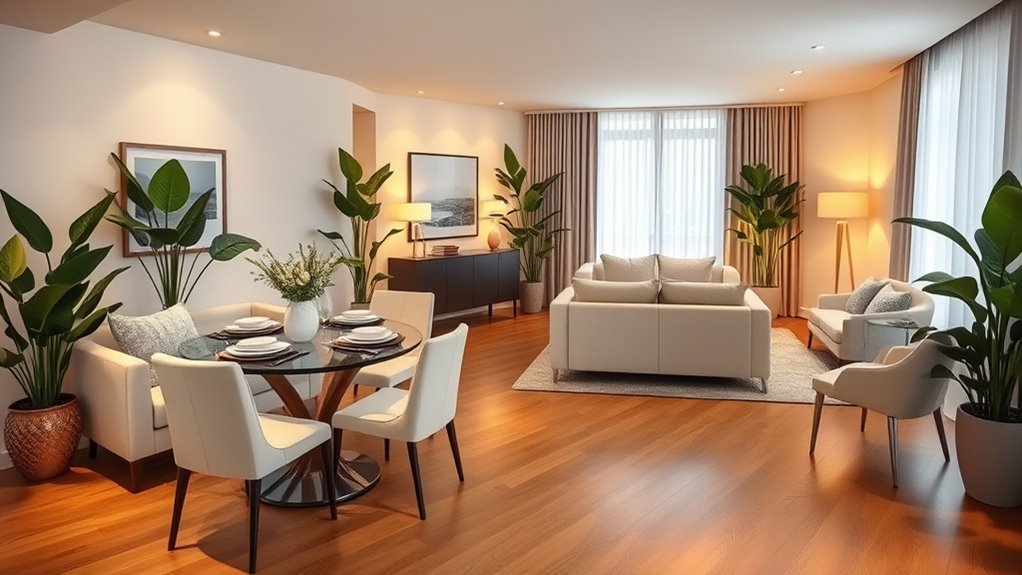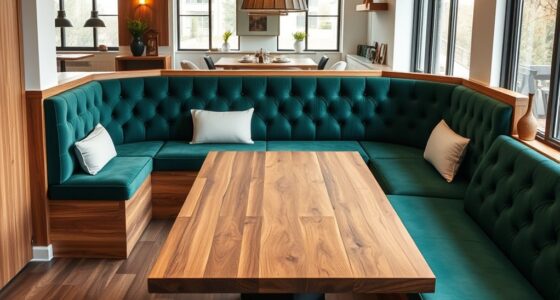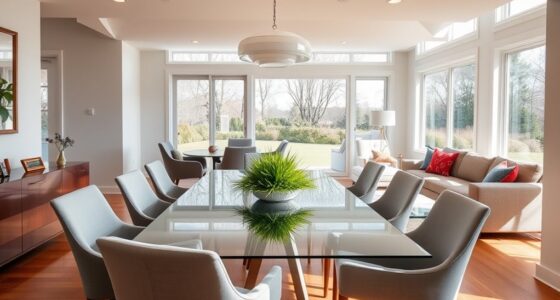To create a cohesive look in your dining and living areas, start by establishing distinct zones. Position your sofa to separate spaces and use large area rugs to anchor furniture. Choose a neutral color palette, layering in a few accent hues for continuity. Mix textures with materials like leather and wood for added depth. Multi-functional furniture can enhance efficiency, keeping your space organized. There’s much more to explore to achieve that perfect blend of style and function.
Key Takeaways
- Use large area rugs to visually anchor both dining and living spaces, creating distinct yet cohesive zones.
- Establish a consistent color palette with neutral base colors and complementary accent hues for seamless transitions.
- Incorporate multi-functional furniture to maximize space efficiency and functionality in open-concept areas.
- Mix textures and materials, such as wood, leather, and textiles, to add depth and interest to both spaces.
- Utilize strategic lighting to enhance ambiance and visually separate the dining and living areas while maintaining a unified look.
Establishing Zones for Functionality
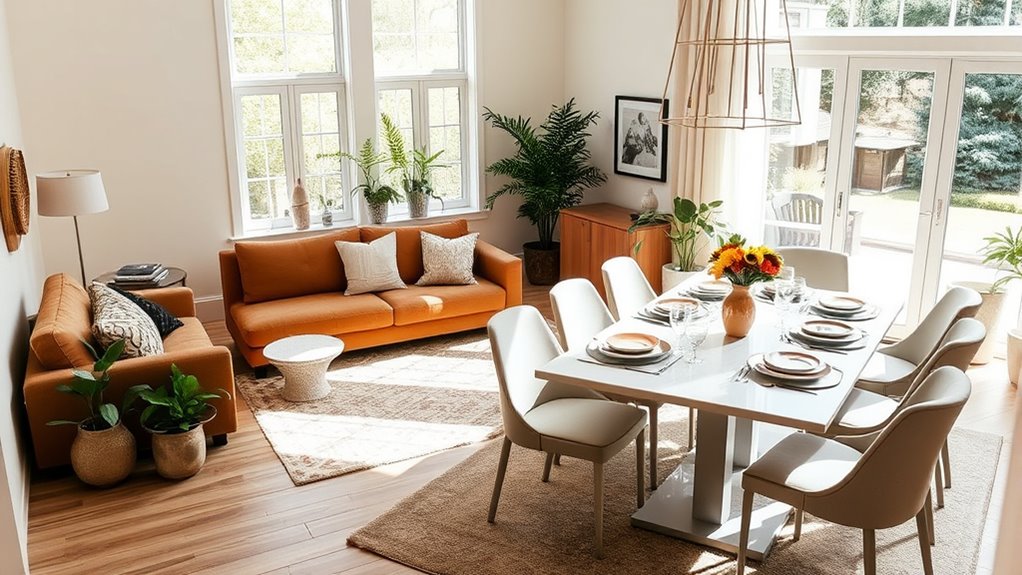
To create a functional and cohesive look in your dining and living areas, you’ll want to establish clear zones that enhance both usability and aesthetic appeal.
Start by considering your furniture layout; positioning the sofa with its back to the dining area can help create distinct zones while maintaining an airy feel. Incorporate large area rugs to define seating areas and anchor your furniture in the open-plan space, adding warmth and texture. Adding natural elements like wood or stone can further enhance the overall aesthetic of the space. Utilizing farmhouse textiles like cozy throw blankets and cushions can also provide additional comfort and charm. Additionally, a well-organized environment can significantly reduce stress levels, promoting a more enjoyable atmosphere. Installing energy-efficient lighting can also elevate the ambiance while supporting a sustainable lifestyle.
Utilize effective lighting strategies, like hanging large pendant lights over the dining table, to visually separate these spaces. Make sure to select multi-functional furniture, such as wall-mounted pull-down tables, to maximize small areas. Additionally, consider incorporating cozy textiles to enhance comfort and create a welcoming atmosphere.
Finally, pay attention to traffic flow, ensuring pathways remain clear for easy access and usability.
Defining Spaces With Rugs and Lighting
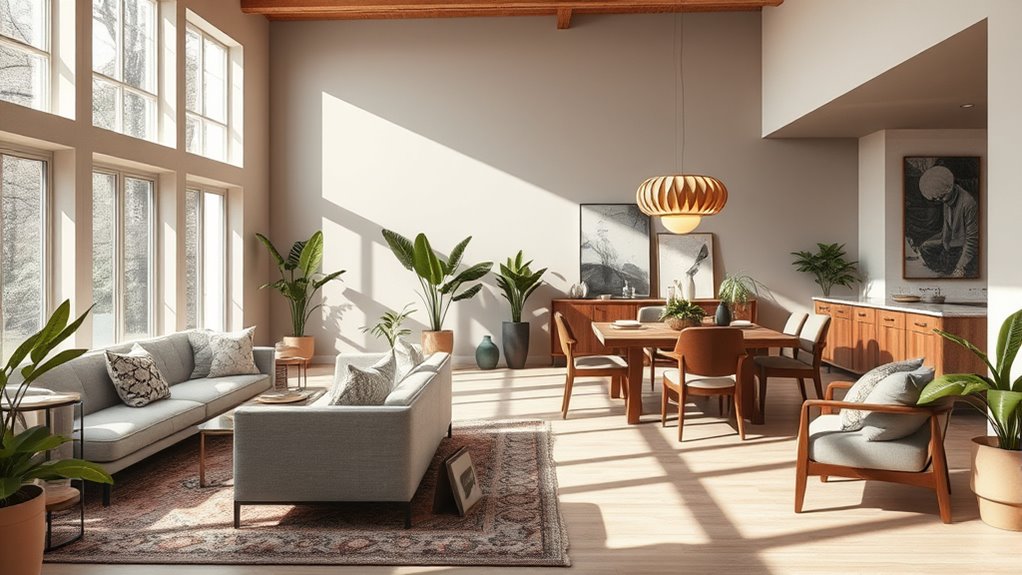
While you may think of rugs and lighting as mere decor, they play an essential role in defining spaces within your dining and living areas. Large area rugs can effectively delineate seating areas in open spaces, providing a visual anchor that enhances comfort. Incorporating natural elements into your decor can further promote tranquility and a cohesive design. The rise of sustainable fashion has also influenced home decor trends, leading to a preference for eco-friendly materials in furnishings. Additionally, choosing oak wood for furniture can add durability and a rustic charm that complements the farmhouse aesthetic.
Opting for pale-toned rugs creates a light and airy feel, perfect for combined areas. Additionally, strategically placed lighting fixtures like pendant lights or floor lamps offer visual separation between distinct areas, enhancing mood and functionality. Incorporating farmhouse-style lighting fixtures can further enhance the overall ambiance of your space. It’s important to consider the impact of wood-burning emissions when selecting materials, as this contributes to a healthier indoor environment.
Choosing a Consistent Color Palette
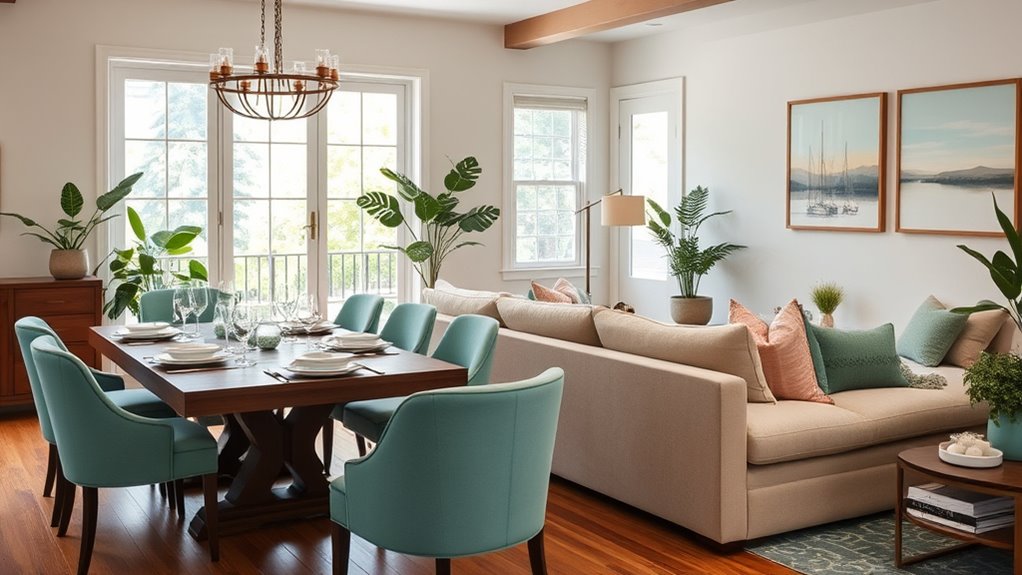
Creating a cohesive look in your dining and living areas hinges on selecting a consistent color palette that ties both spaces together.
A unified color palette is essential for achieving harmony between your dining and living spaces.
Start with a neutral base color to establish a strong foundation, then layer in three to four accent hues for continuity.
Here are some tips to take into account:
- Use variations of the same color tone for a seamless shift.
- Incorporate a standout piece of art or patterned wallpaper to unify the color palette.
- Confirm the chosen colors enhance natural light and create an inviting ambiance.
- Regularly evaluate the scheme to align with your personal style.
Mixing Textures and Materials
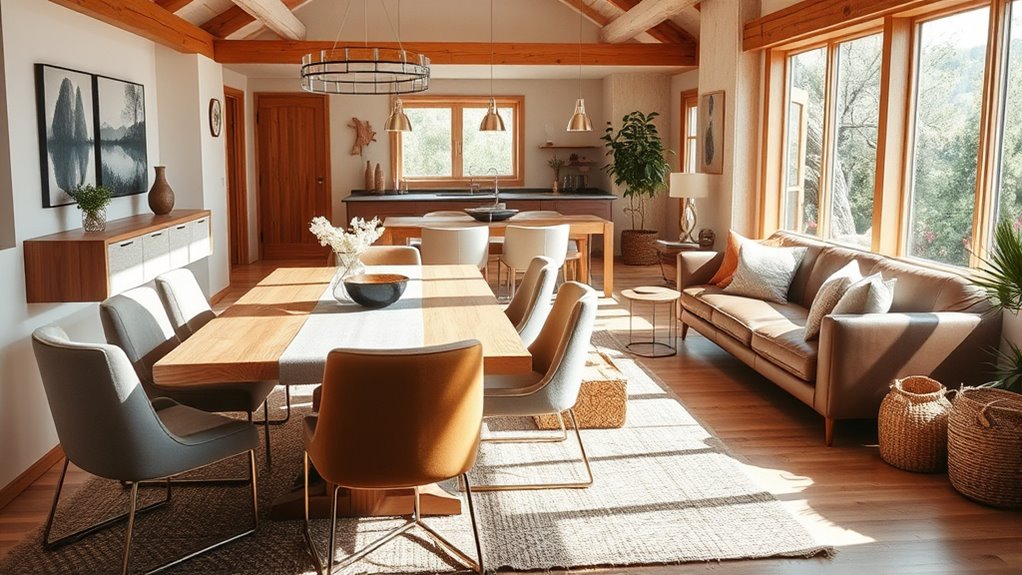
Mixing textures and materials can transform your dining and living areas into a dynamic and inviting space. By incorporating a variety of textures, like soft textiles, smooth woods, and metallic accents, you’ll add visual interest and depth.
Consider using leather for seating, woven fabrics for cushions, and natural wood for your tables to create a comfortable and warm environment. Layering textures, such as velvet throw pillows with linen curtains, enhances the aesthetic while reflecting your personal style.
Textured area rugs can anchor your furniture, reinforcing cohesion between different spaces while adding warmth underfoot. Guarantee your balanced combination of textures aligns with your overall design theme, so each element complements rather than competes with the others in your home.
Incorporating Multi-Functional Furniture
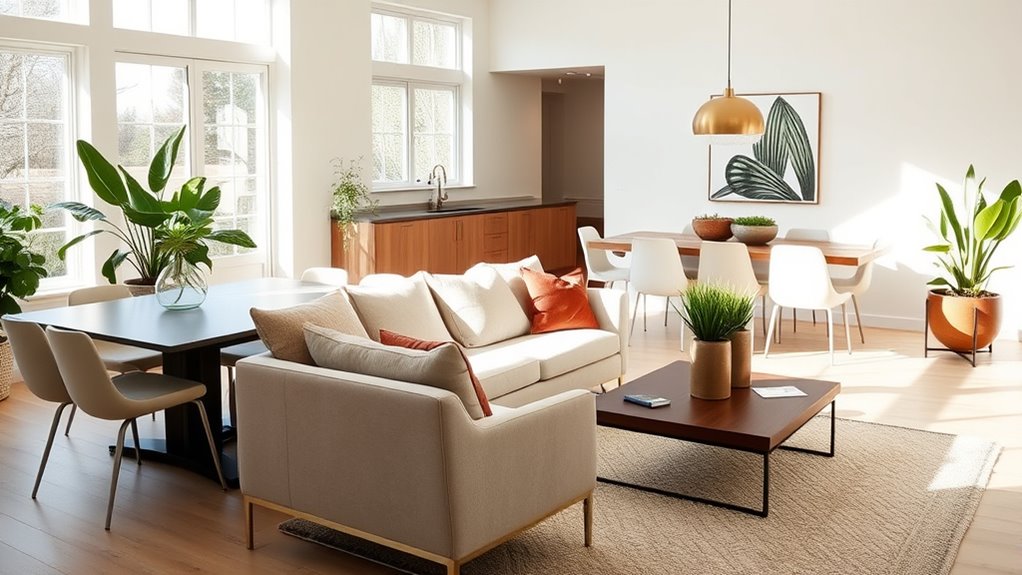
Incorporating multi-functional furniture is a smart way to enhance both style and practicality in your dining and living areas.
This approach maximizes space efficiency, especially in open-concept living spaces. Here are some ideas to reflect on:
- Dining tables that double as a workspace for seamless meal and work shifts.
- Ottomans with storage to provide extra seating while reducing clutter.
- Wall-mounted drop-leaf tables that fold away, freeing up floor space when not in use.
- Modular furniture like sectional sofas that adapt to different occasions and gatherings.
Personalizing Your Decor
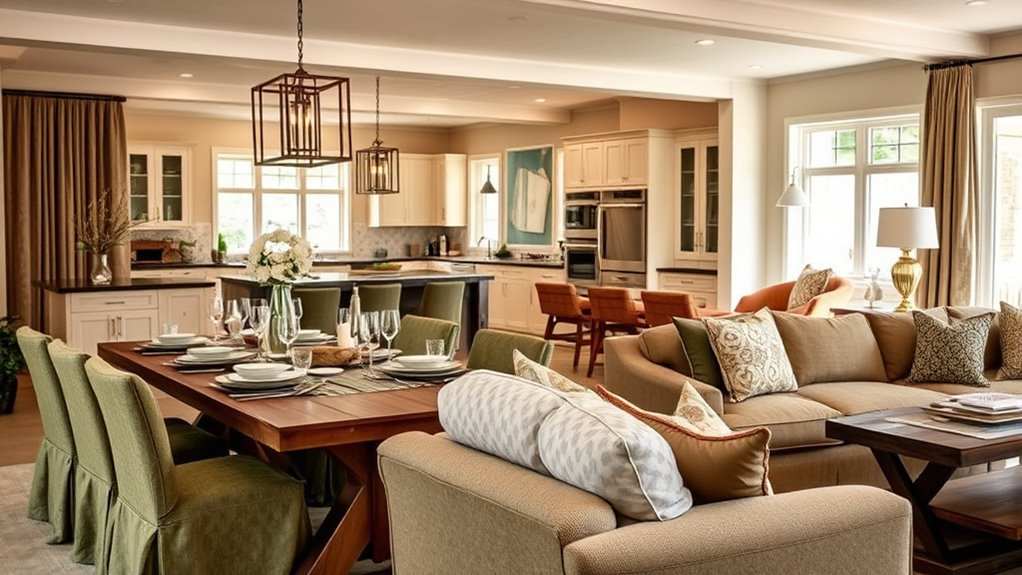
While personalizing your decor might seem challenging, it’s really about showcasing what matters to you. Start by filling your space with meaningful items like family photos and unique collectibles that tell your story.
Use a consistent color palette across your dining and living areas, incorporating your favorite color as an accent in various decor pieces. Mixing vintage and modern furniture styles not only adds character but also reflects your personal aesthetic.
Select artwork that resonates with your taste, positioning standout pieces as visual focal points. Remember to regularly reassess and edit your decor to keep your home aligned with your evolving personal style, ensuring each element contributes to your overall vision.
Frequently Asked Questions
How to Design a Dining and Living Room?
To design a dining and living room, start by choosing a color palette that reflects your style.
Use rugs to define each area and add warmth.
Consider large furniture pieces to create visual separation, like a sofa dividing the two spaces.
Layer your lighting with pendant lights and floor lamps to enhance both areas’ ambiance.
Finally, mix vintage and modern furniture for character, ensuring each piece complements your overall design without feeling mismatched.
How Do You Create a Cohesive Design?
To create a cohesive design, you should start by selecting a unified color palette that flows throughout your space.
Incorporate consistent materials and textures to enhance visual harmony. Use rugs to define areas while maintaining a shared design theme.
Choose furniture pieces that complement each other without being overly matchy.
Finally, layer different lighting sources to create a balanced ambiance, tying everything together beautifully and ensuring a seamless look throughout your home.
What Is the 2/3 Rule for Living Rooms?
The 2/3 rule for living rooms suggests that your furniture and decor should fill about two-thirds of your wall space.
This guideline helps you achieve balance and visual appeal, preventing your decor from overwhelming the area.
By considering the proportions of your seating and tables, you can create a harmonious atmosphere.
Use this rule to thoughtfully place art and shelving, ensuring your space feels inviting and well-organized.
How to Divide a Living Room and Dining Room Combo?
Imagine your living space as a canvas, waiting for your artistic touch.
To divide your living room and dining room combo, employ large furniture pieces like sofas and tables to carve out distinct zones.
Layer rugs beneath each area to add warmth and texture, while unique lighting fixtures serve as visual anchors.
Keep your color palette harmonious, allowing variations in texture to dance across the space, creating interest without chaos.
Conclusion
As you wrap up your design journey, remember that every choice you make counts. Picture how the colors, textures, and furniture come together, creating a haven that reflects your style. What will you add next to elevate your space? Perhaps a statement piece or a hidden gem? The possibilities are endless, and the magic lies in the details. So, take a step back, breathe in the beauty, and let your cohesive dining and living areas tell your unique story.
